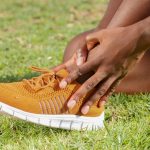After a long day of standing, you can relieve tension and restore comfort through several effective recovery techniques. Start with gentle stretching exercises to loosen tight muscles. Foot soaks in warm water with Epsom salt can provide instant relief. Consider massage techniques using your hands or a foam roller to ease sore spots. Elevating your legs boosts circulation, while proper hydration and nutrition support recovery. There’s plenty more to discover about optimizing your recovery methods.
Table of Contents
Key Takeaways
- Perform stretching exercises like calf and quadriceps stretches to relieve tension and improve flexibility after prolonged standing.
- Soak your feet in warm water with Epsom salt and essential oils for 15-20 minutes to reduce inflammation and enhance relaxation.
- Use massage techniques, such as kneading sore areas or foam rolling, to promote blood flow and alleviate muscle soreness.
- Elevate your legs above heart level to improve circulation and reduce swelling, providing relief after a long day on your feet.
- Stay hydrated and consume nutrient-rich foods, like leafy greens and lean proteins, to support recovery and replenish energy levels.
Stretching Exercises to Relieve Tension
When you’ve been standing for long periods, your muscles can feel tight and fatigued, but stretching can work wonders to relieve that tension.
Start with a simple calf stretch: step back with one foot, keeping it straight, and lean into the front leg until you feel a pull in your calf. Hold for 15-30 seconds, then switch legs.
Begin with a calf stretch: step back with one leg, lean forward, and feel the pull. Hold, then switch sides.
Next, try a standing quadriceps stretch by grabbing your ankle and pulling your heel toward your glutes. This helps ease tightness in your thighs.
Finally, don’t forget your lower back; reach for your toes while standing to release tension there.
Incorporating these stretches into your routine can greatly enhance your comfort after a long day on your feet. Get moving!
Foot Soaks for Instant Relief
If you want to quickly soothe your tired feet after standing all day, foot soaks can be a game changer. Simply fill a basin or tub with warm water and add Epsom salt, which helps reduce inflammation and relaxes muscles.
You can also include essential oils like lavender or peppermint for added comfort and relaxation. Soak your feet for about 15 to 20 minutes, letting the warm water work its magic.
This simple technique not only alleviates pain but also improves circulation. After soaking, gently pat your feet dry and consider applying a moisturizer to keep your skin soft.
Incorporating foot soaks into your recovery routine can provide instant relief and leave you feeling rejuvenated.
Massage Techniques for Sore Muscles
While you may feel like your muscles are screaming for relief after a long day of standing, massage techniques can work wonders in easing soreness.
Start by using your hands to knead tight areas, applying pressure with your fingertips or palms. Focus on your calves, thighs, and lower back, as these spots often hold tension.
You can also use a foam roller to roll out knots, which helps increase blood flow and flexibility. If you have a massage ball, try placing it under your feet or against a wall to target specific sore areas.
Don’t forget to breathe deeply, as this can enhance relaxation. Regularly incorporating these techniques can lead to quicker recovery and improved overall comfort.
Elevating Your Legs for Circulation
To enhance circulation and reduce swelling after a long day of standing, elevating your legs can be incredibly effective. By raising your legs above heart level, you promote better blood flow and relieve pressure from your feet and ankles. This simple technique can help alleviate discomfort and prevent long-term issues.
| Position | Benefits |
|---|---|
| Lying flat | Complete relaxation |
| Legs on a pillow | Reduces swelling |
| Against a wall | Easy to do anywhere |
| Reclining chair | Comfortable support |
| Feet elevated | Improves venous return |
Try incorporating leg elevation into your evening routine. You’ll notice a significant improvement in how your legs feel, making your recovery much more effective.
Hydration and Nutrition for Recovery
After standing for long periods, your body needs proper hydration and nutrient-rich foods to recover effectively.
Drinking enough water helps replenish lost fluids, while consuming a balanced diet fuels your muscles and promotes healing.
Let’s explore how these elements play an essential role in your recovery process.
Importance of Hydration
Hydration plays an essential role in your recovery after prolonged standing, as it helps replenish the fluids lost through sweat and supports overall bodily functions.
When you’re on your feet all day, your body loses water, which can lead to fatigue, muscle cramps, and decreased performance. Drinking enough water helps maintain your energy levels and keeps your joints lubricated, reducing the risk of discomfort.
Aim to sip water consistently throughout the day, rather than waiting until you feel thirsty. If you’ve been sweating heavily, consider electrolyte-rich drinks to restore lost minerals.
Nutrient-Rich Foods
While staying hydrated is essential, fueling your body with nutrient-rich foods is equally important for recovery after standing for long periods. Incorporating the right foods can help replenish energy, reduce inflammation, and promote muscle recovery. Focus on whole foods packed with vitamins and minerals.
Here’s a quick guide to nutrient-rich options:
| Food Type | Benefits |
|---|---|
| Leafy Greens | High in vitamins & antioxidants |
| Lean Proteins | Supports muscle repair |
| Whole Grains | Provides sustained energy |
| Nuts & Seeds | Packed with healthy fats |
Using Foam Rollers for Muscle Release
Foam rolling can be a game changer for your muscle recovery after long periods of standing.
By applying pressure to specific areas, you can release tension and improve circulation.
Let’s explore the benefits, effective techniques, and the best types of foam rollers to enhance your recovery routine.
Benefits of Foam Rolling
One effective way to enhance muscle recovery after standing is through foam rolling. This technique offers numerous benefits that can help you feel rejuvenated and ready to take on the day.
Here are some key advantages of foam rolling:
- Reduces Muscle Soreness: It helps alleviate the discomfort that often comes from long hours of standing.
- Increases Flexibility: By releasing tight muscles, you can improve your overall range of motion.
- Boosts Circulation: Foam rolling stimulates blood flow, aiding in the delivery of nutrients to sore muscles.
- Enhances Relaxation: The rhythmic pressure can promote a sense of relaxation, helping to unwind after a long day.
Incorporating foam rolling into your routine can transform how your body feels and recovers.
Techniques for Effective Release
To effectively release muscle tension using foam rollers, you’ll want to focus on specific techniques that target the areas most affected by prolonged standing.
Start by placing the foam roller under your calves, gently rolling back and forth for about 30 seconds. Next, move to your hamstrings; sit on the roller and roll from your knees to your glutes.
For your lower back, lie on the roller horizontally and gently roll side to side. Don’t forget your feet—stand on the roller and shift your weight to massage the arches.
Finally, take deep breaths while rolling to enhance relaxation. Integrating these techniques into your routine will help alleviate tension and promote recovery.
Recommended Foam Roller Types
Selecting the right foam roller can greatly enhance your muscle release experience.
With so many options available, it’s crucial to find one that suits your needs. Here are four recommended types to think about:
- Standard Foam Roller: Great for beginners, these provide a gentle release for sore muscles.
- Grid Foam Roller: With different textures, it targets tight spots effectively, giving you that satisfying relief.
- High-Density Foam Roller: Perfect for more experienced users, it offers deeper pressure for stubborn knots.
- Trigger Point Foam Roller: Equipped with raised bumps, it mimics a massage therapist’s hands for intense muscle release.
Choosing the right roller can make a significant difference, helping you recover faster and feel better after a long day on your feet.
Relaxation Techniques to Unwind and De-stress
While standing for long periods can take a toll on your body and mind, incorporating effective relaxation techniques can help you unwind and de-stress.
Start by practicing deep breathing exercises. Inhale slowly through your nose, hold for a few seconds, then exhale through your mouth. This simple technique calms your nervous system.
Practice deep breathing: inhale through your nose, hold, then exhale through your mouth to soothe your nervous system.
Next, consider progressive muscle relaxation; tense and then relax each muscle group, starting from your toes and working your way up. You can also try gentle stretching to release tension in your legs and back.
Finally, don’t underestimate the power of a warm bath or soothing music. These activities create a peaceful environment, allowing you to recharge and feel rejuvenated after a long day of standing.
Frequently Asked Questions
How Often Should I Take Breaks While Standing?
Oh, you think standing all day’s a breeze? You should take breaks every 30 to 60 minutes. It’ll keep your energy up and prevent fatigue. Trust me, your feet will thank you later!
Can Wearing Supportive Shoes Prevent Soreness?
Yes, wearing supportive shoes can definitely help prevent soreness. They provide cushioning and stability, reducing pressure on your feet. Choosing the right footwear is essential for maintaining comfort and preventing fatigue during long hours of standing.
What Are the Signs I Need Professional Help?
If you’re experiencing persistent pain, numbness, or swelling, it’s time to seek professional help. Don’t ignore severe discomfort or changes in your mobility, as these could indicate underlying issues needing medical attention.
Is It Safe to Exercise After a Long Day of Standing?
Yes, it’s safe to exercise after a long day of standing, but listen to your body. Light stretching or low-impact activities can help relieve tension and improve circulation. Just avoid intense workouts if you feel too fatigued.
How Can I Improve My Posture While Standing?
To improve your posture while standing, keep your feet shoulder-width apart, weight balanced on both legs, and engage your core. Imagine a string pulling you upward from your head, aligning your spine and shoulders.




